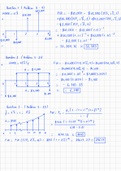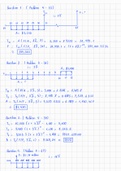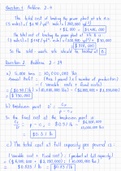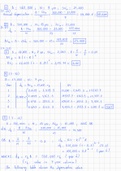Engineering Economics (Econ343)
Rutgers University - New Brunswick/Piscataway
Página 2 fuera de 14 resultados
Ordenador por

-
HW7_Profitability Measures (PW, FW, AW)_EngEconomics
- Otro • 2 páginas • 2023
- Disponible en paquete
-
- $2.99
- + aprende más y mejor
The three most commonly used profitability measures are present worth (PW), future worth (FW), and annual worth (AW). Each measure provides a different perspective on the profitability of an investment, and engineers can use them in combination to make informed decisions about the use of resources. Present worth (PW) is the value of all future cash flows of an investment at the present time. Engineers use the present worth factor to calculate the present worth of an investment, taking into ac...

-
HW5_Deferred Annuities and More Complicated Equivalence Calculations_EE
- Otro • 2 páginas • 2023
- Disponible en paquete
-
- $2.99
- + aprende más y mejor
A deferred annuity is an annuity that does not begin making payments until a specified date in the future. In engineering economy, deferred annuities are often used to evaluate investments in which cash inflows or outflows are expected to occur at a future date. Engineers use present worth, future worth, annual worth, and nominal rate factors to calculate the value of deferred annuities and compare them to other investment options. In more complicated equivalence calculations, engineers may u...

-
HW3_Cost Concepts and Design Economics_EngEconomics
- Otro • 3 páginas • 2023
- Disponible en paquete
-
- $2.99
- + aprende más y mejor
Cost concepts refer to the various types of costs that are involved in a project, including direct costs (such as labor and materials) and indirect costs (such as overhead and administration expenses). These costs are analyzed and quantified in order to determine the total cost of a project. Understanding cost concepts is important for engineers because it allows them to accurately estimate the costs associated with a project and identify areas where cost savings can be made. Design economics...

-
HW12 - Chapter 7: Depreciation and Income Taxes
- Otro • 3 páginas • 2023
-
- $2.99
- + aprende más y mejor
It discusses the different methods of depreciation (such as straight-line, declining balance, and sum-of-the-years' digits), how to calculate depreciation expenses, and the impact of different depreciation methods on income taxes. The chapter also covers the basics of income taxes, including the different types of taxes and tax rates, tax deductions and credits, and how to calculate income tax expenses.

¿Miedo a perderte algo? Pues no lo hagas.

¿Te preguntas por qué tantos estudiantes llevan ropa bonita, tienen dinero de sobra y disfrutan de toneladas de tiempo libre? ¡Pues se venden en Stuvia! Imagina que tus apuntes de estudio se descargan una docena de veces por 15 euros cada uno. Todos. Los. Dias. Descubre todo sobre cómo ganar en Stuvia

